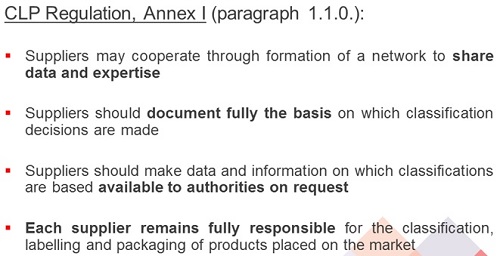Welcome
Organising a network

In line with the CLP provisions allowing the formation of a classification network and building on the CLP hierarchy of data for classification, A.I.S.E. initiated a broad project with the objective to secure adequate data generation for safety assessment, and thus, classification and labelling of products.
The purpose of organizing a network is to maximise the use of existing information and bring together expertise in the evaluation of information, test data, weight of evidence determinations and bridging principles. Sector-harmonisation is also in line with the internal market objective of the CLP Regulation.
Transitional provisions for mixtures
For Until 01 June 2015
Mixtures have to be classified, labelled and packaged in accordance with the DPD until 01 June 2015. In addition, mixtures may be classified, labelled and packaged according to CLP before 01 June 2015 (in this case, DPD labelling and packaging provisions do not apply).
If CLP is applied to a mixture before 01 June 2015, the Safety Data Sheet (Annex II REACH) must contain both the DPD and CLP classifications of the mixture.
Mixtures classified, labelled and packaged according to the DPD and already placed on the market before 01 June 2015, do not require re-labelling and re-packaging according to CLP until 01 June 2017.
After 01 June 2015
DSD and DPD are repealed; only CLP remains in force. Where a mixture has been classified according to the DPD before 01 June 2015, suppliers may amend the classification of the mixture using the translation table in Annex VII (Art. 61.5 – similar provisions apply to substances classified before 01 December 2010). It should be noted however that (i) direct translation is not possible for certain endpoints and (ii) Annex VII indicates that an evaluation and classification must be carried out in accordance with Articles 9 – 13 when data for the mixture are available.
A supplier cannot decide to apply CLP for certain hazard classes only during the transitional period. If a supplier decides to apply CLP for mixtures before 01 June 2015 then they must implement CLP provisions in full.
To whom does it apply?
The CLP Regulation (EC) No 1272/2008 applies to a wide range of actors in the supply chain who manufacture, import, use, or distribute chemical substances and mixtures within the EU/EEA. Their responsibilities vary depending on their role:
Manufacturers, importers, and downstream users
- Must classify substances and mixtures before placing them on the market, based on available data and CLP criteria.
- Are responsible for labelling and packaging hazardous substances and mixtures in accordance with CLP requirements.
- Must notify the classification and labelling of substances to ECHA’s C&L Inventory if not already submitted via a REACH registration. This applies to:
- Hazardous substances placed on the market (including imports);
- Substances in mixtures above classification thresholds;
- Substances subject to REACH registration or notification.
Distributors
- Defined as entities that store and place on the market substances or mixtures without altering their chemical composition.
- Must ensure that products are correctly labelled and packaged according to CLP before sale.
- Are responsible for communicating safety information down the supply chain, including providing safety data sheets in the appropriate national language.
Suppliers
- The term “supplier” includes manufacturers, importers, downstream users, and distributors who place substances or mixtures on the market.
- All suppliers must ensure compliance with CLP labelling, packaging, and notification obligations.
Downstream users
- Are entities other than manufacturers or importers who use substances or mixtures in industrial or professional activities.
- Must classify substances or mixtures if they modify them or use them in a way that changes their classification.
- Re-importers (under REACH Article 2(7)(c)) are considered downstream users if the substance has already been registered upstream.